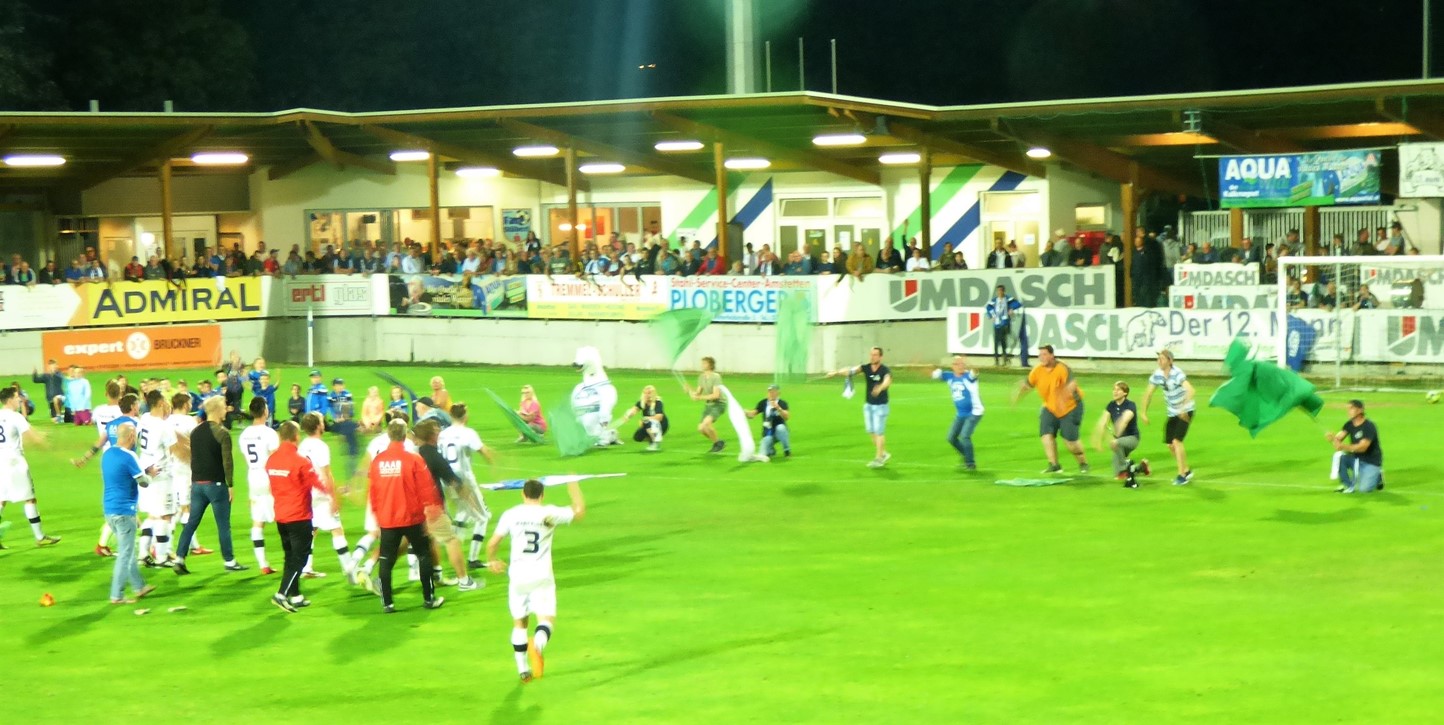Eurohop – Part 1
In England, the groundhopper has been a part of the non-league scene for many decades now. There are several hundreds of people who travel up and down the country “ticking” the small grounds. The hobby has spread to other countries as well, with Germany probably having more practitioners than the UK, and others coming from Scandinavia, the Netherlands and Switzerland.
I am not an expert on linguistics, but I have long held the belief that there is a linguistic grouping in the type of behaviour that leads to hobbies such as groundhopping (see also trainspotting, stamp collecting, etc.). In fact, this appears to go for any hobby which requires at least mild obsessive-compulsive actions. The desire to complete one set, and then go in search of another set does not appear to be so pronounced with people who speak Latin based languages (such as French, Italian and Spanish). Belgian hoppers are more likely to be Flemish speakers than Walloon, and Swiss hoppers are almost inevitably German speakers.
Of course, football goes beyond borders, and so not surprisingly, groundhopping does too. The most well-travelled groundhopper I know in England has, I believe watch football in 117 countries, and is at pains to say this is only FIFA members. It certainly puts my 71 countries (to date) in the shade, but some of the German hoppers are likely to have beaten these figures.
My figure, incidentally allows me to count Monaco (which is not a FIFA member, but is a member of the UN as a separate country). Monaco is odd insofar as while the football played in the principality is in the French Leagues, the grounds used for the main Monegasque competition are in France. The one I have been to, the Stade Plage Marquet Cap d’Ail is only just behind the arches of Monaco’s Stade Louis II

It has become a common theme with those of us that travel the grounds of Europe to make a tour in May, as the English season is drawing to a close. If one travels some long distances, then it may be possible to do games every day on a two to three-week period, even as those grounds already visited are not part of the equation. Yes, I do go to grounds I have been to before, but in the obsessive nature of hopping, each ground can only be “ticked” once. Two of those who have travelled with me most often in the past are in Europe at the same time as this trip. My son has given them both nicknames, so to avoid undue publicity, they will be referred to as Pizzaman and the Minion. The whole trip will be coloured slightly by the fact that another regular traveller, Paul Sparrow is no longer with us.
These trips are by rail, with us holding interrail tickets which makes the long runs easier. When we were younger, the trips would always include a fair number of overnight trains, but these days we tend to prefer hotel accommodation as much as the timetables allow. Interrail means that we are not stuck to the same itineraries. Our past records mean we want different grounds. In particular, the Minion and Pizzaman have done more of this type of trip than myself, but I have probably done more solo trips at other times.
So, I get a one-day head start, and this is typed from the Vienna to Graz train. Pizzaman will follow the same route 21 hours behind me, and we will then meet up and head to Slovenia. The Minion is coming into Vienna with Pizzaman, but I am not seeing him until Saturday, when we reach Germany.
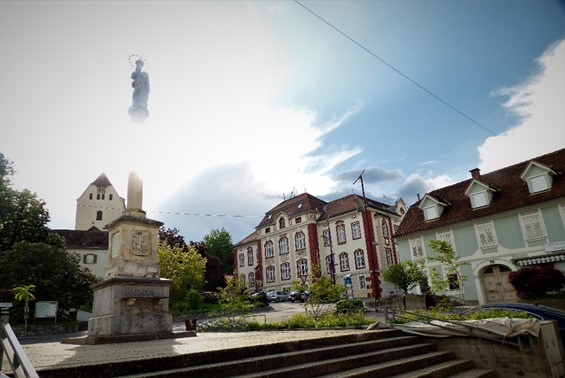
My first game is in the Austrian Regionalliga Mitte, a match between SC Weiz and Vorwarts Steyr. This was always my intention when starting the trip, but just after I had booked my ticket, it was switched from Tuesday to Wednesday. Then two weeks later, the Austrian Cup final was scheduled for the Wednesday and my game was returned to the Tuesday. Austria has two professional divisions, which if we remove sponsors logos are Bundesliga and 1. Liga. They have been running with ten teams each and a 36-game season, but this is due to change next season. The Bundesliga will go to the 12-team format that is gaining in popularity. After 22 games, it will split into two groups, with the winner of the lower group is included in the play-off for the last Europa League place. The second tier will expand from 10 to 16 teams, meaning 8 new teams coming up from the three regionalliga. Champions and Runners-up should go up of right, and it appears two of the three third placed teams will go straight up, the third having a play-off against the bottom team in the 1. Liga. Although I had not seen this written, I had suspected that Regionalliga Mitte had drawn this short straw as they were finishing a week ahead of the other two – this would have made sense when the 1. Liga had an earlier finish but it now runs on to the same weekend of the Ost and West Regionalliga finish
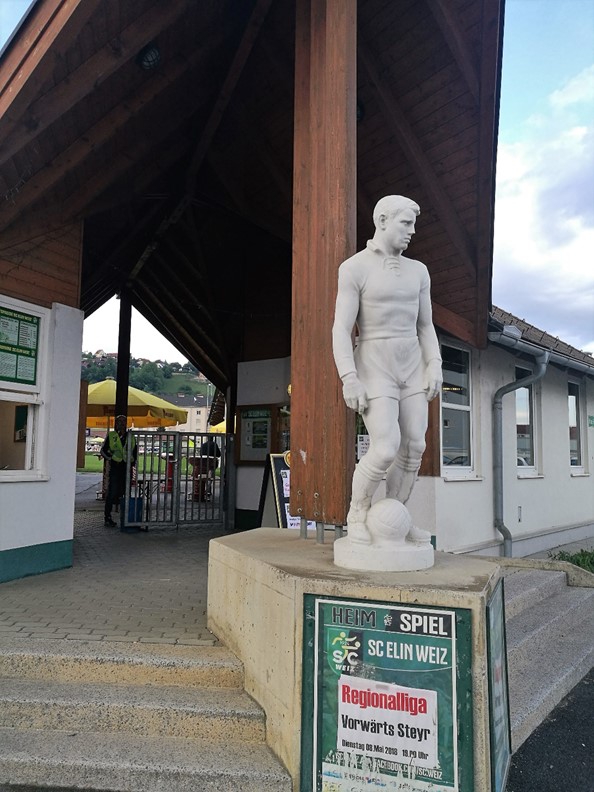
As it happens events have got in the way. The Austrian Football Association have been hard pressed to find enough teams to bring the second level up to 16. It appears that the bottom team in the current 1.Liga will be reprieved from even a relegation play-off. Once those clubs who either do not want to be promoted, or cannot get a licence, it appears that only one club can be promoted from the Regionalliga West, Three from Regionalliga Ost, leaving four from the Mitte. Even then, it is not a matter of finishing in the top four. Neither Gleisdorf 09 (second when I started the tour), nor Union Vöcklamarkt (4th) want promotion, while Allerheiligen (7th) cannot get a licence. It is fairly certain that Lafnitz (confirmed as champions), Pasching/LASK Juniors (3rd), Vorwärts Steyr (5th) and Austria Klagenfurt (6th) will be promoted.
I arrive in Weiz by train quite and check into my hotel mid-afternoon. Weiz is a pleasant enough town, but very quiet with little happening. It is surrounded by hills, and therefore gets visitors who want to trek and take in the scenery. It is only a ten-minute walk from my hotel to the Stadium. The ground is basically two sided, with a few rows of terracing (uncovered) behind the goal as you enter, and covered stand running the entire length of one side. There is space behind the other goal, but this is grassed, with the area near the dressing rooms unused, and that further away having a marquee for use by the VIPs. It was not well used.
The other long side is very narrow and is an overgrown steep slope, interrupted only by team benches and the scoreboard.
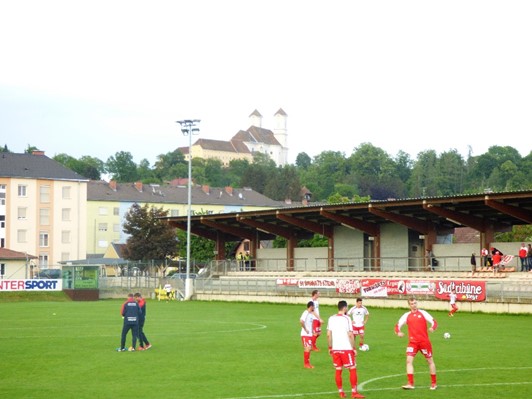
When I arrived, they had opened an extra gate and put a fence between the end terrace and the rest of the ground, but when it became clear the visiting fans numbered a couple of dozen, not a couple of hundred this was abandoned, allowing the fans to mix freely, or more accurately allowing the visiting fans to find a good position to hang their surprisingly large array of flags.
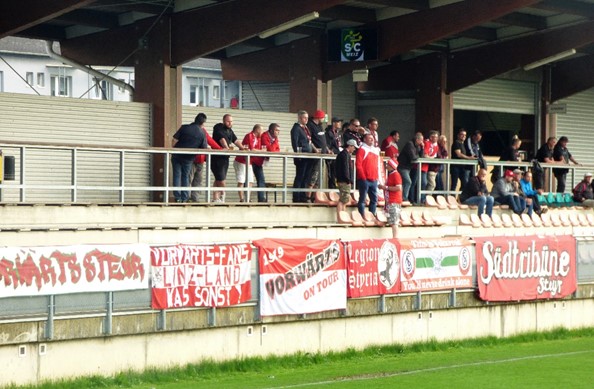
Even though it was not a promotion requirement, I was told by a home official that Vorwärts still wanted to win and hence “earn” promotion, rather than gain it by default. The early stages of the game certainly suggested this was true, with them having a couple of chances before the division’s leading goalscorer, Yusuf Efendioglu found himself receiving a cross unmarked to open the scoring in the 8th minute. Steyr committed enough men forward that when their full back was disposed five minutes later, they did not have cover to prevent Weiz equalising, but quite quickly Efendioglu got on the scoresheet again to regain the advantage. For the rest of the first half, Steyr were well on top, and it was a surprise that they could not increase the lead. Weiz’s efforts were very limited and easily blocked.
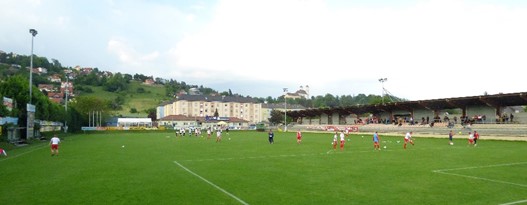
In the second period, Weiz played better, committed more men to attack and created more chances, but still the edge was with the visitors. Lichtenberger hit a rising shot against the crossbar, and Efendioglu managed to balloon over an easy chance to complete his hat-trick. As the half wore on, and a mix of substitutions and yellow cards broke up the play, Weiz were still pushing to get back into the game. It was not until the 89th minute that Efendioglu managed to beat both defender and keeper to a loose ball to complete the scoring (leaving both of his opponents in a heap on the ground)
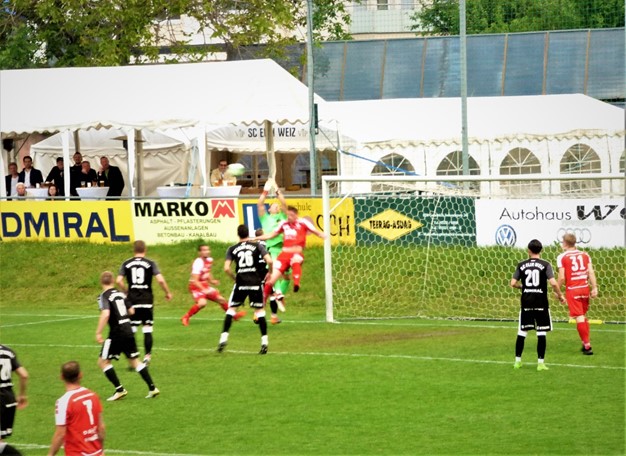
The result lifts Vorwärts into third place, two points behind Gleisdorf, with two games to play.
The next morning it was out of the hotel by 8, and on the train back to Graz. Here I had an hour for a coffee and to update my writings while waiting for the Pizzaman to arrive on the through train from Vienna to Ljubljana. Pizzaman sent me a message to say where he was on the train and we headed onward.
Considering the potential for things to go wrong, the Slovenian leg of the trip was smooth in a way that the football presented during it was not. Originally the thought was to go to Velenje on the Wednesday, for an evening game, and Kranj the next day for an afternoon one, but realising that the timing of the fixtures, (4, 6 and 8 o’clock on the Wednesday) meant it would be possible to go to both Domzale and Velenje on this day. The only catch being that one had to cover the 60km between the two by road. Once I had discovered that I could hire a car for as little as €18 for a day from a place very close to Ljubljana station, the plan was straight forward. With the train into Ljubljana being delayed, I called ahead to the rental company and asked that the car would be ready for a hurried take up. The company (Inter rent) were very good about this, and we just had to go through the normal paperwork before driving away. We arrived in Domzale around 50 minutes before kick off and parked in the car park for a supermarket, which backs onto the main stand.
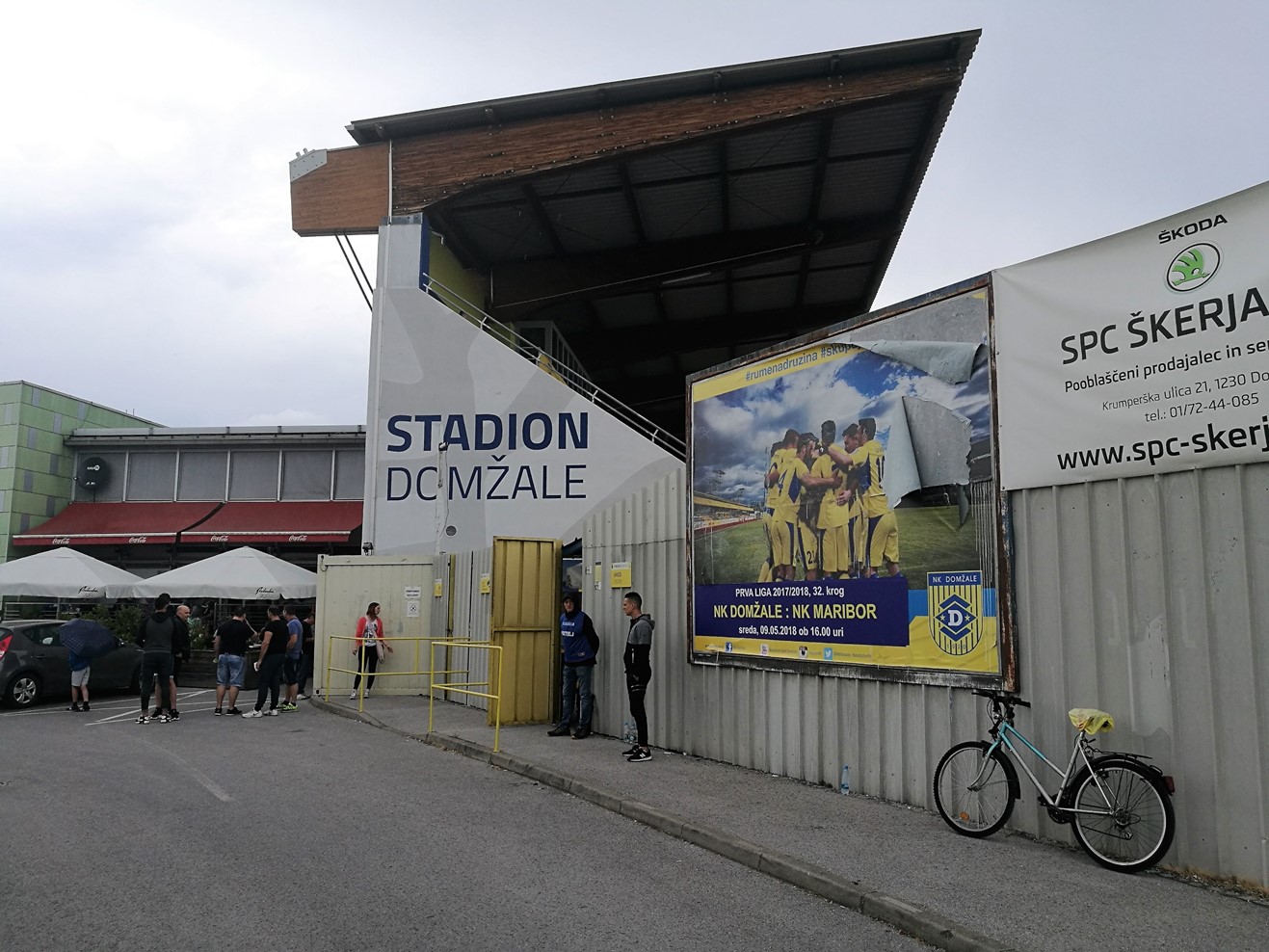
All three of the grounds we were to visit in Slovenia had running tracks around them, and a main stand to one side. The away sides for the Wednesday matches were the two best supported teams in the league. Both Olimpija Ljubljana and Maribor claim over 3,000 supporters for their home games, while the next best in the league still get under 1000. In both cases, this resulted in a similar setting for the visiting fans, with a section for the “ultras” who would stand and sing during the game, and then the next block being occupied by the other visiting fans, who would sit and support their club in a quieter manner. There were some police and security around, but nothing to suggest that there would be any problems. Everyone was arriving and leaving through the same routes.
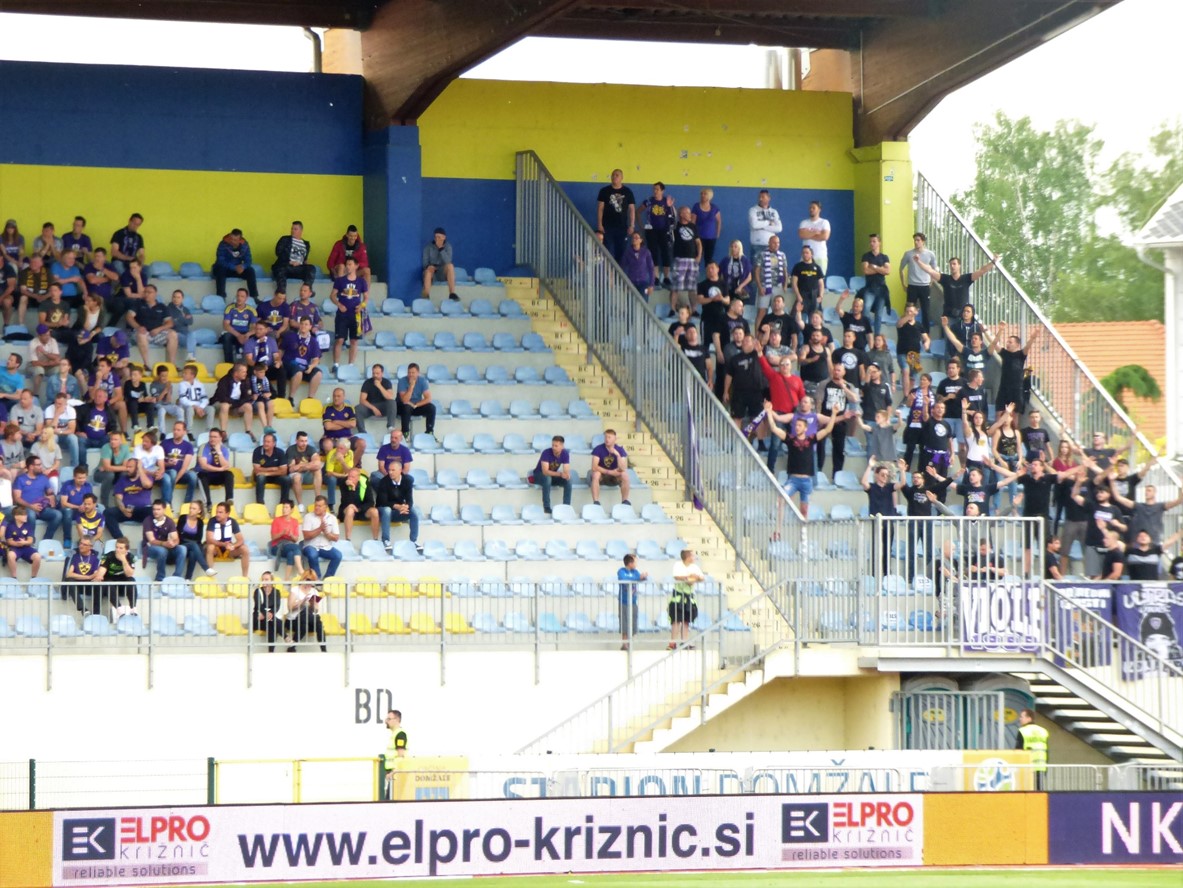
Maribor Ultras in Domzale.
One thing that does differentiate these Slovenian games from most of those I go to in Europe appeared to be the limited catering. As far as I could see, none of the clubs were selling any food to their patrons at all, and the only drinks options were for cold drinks, including lager.
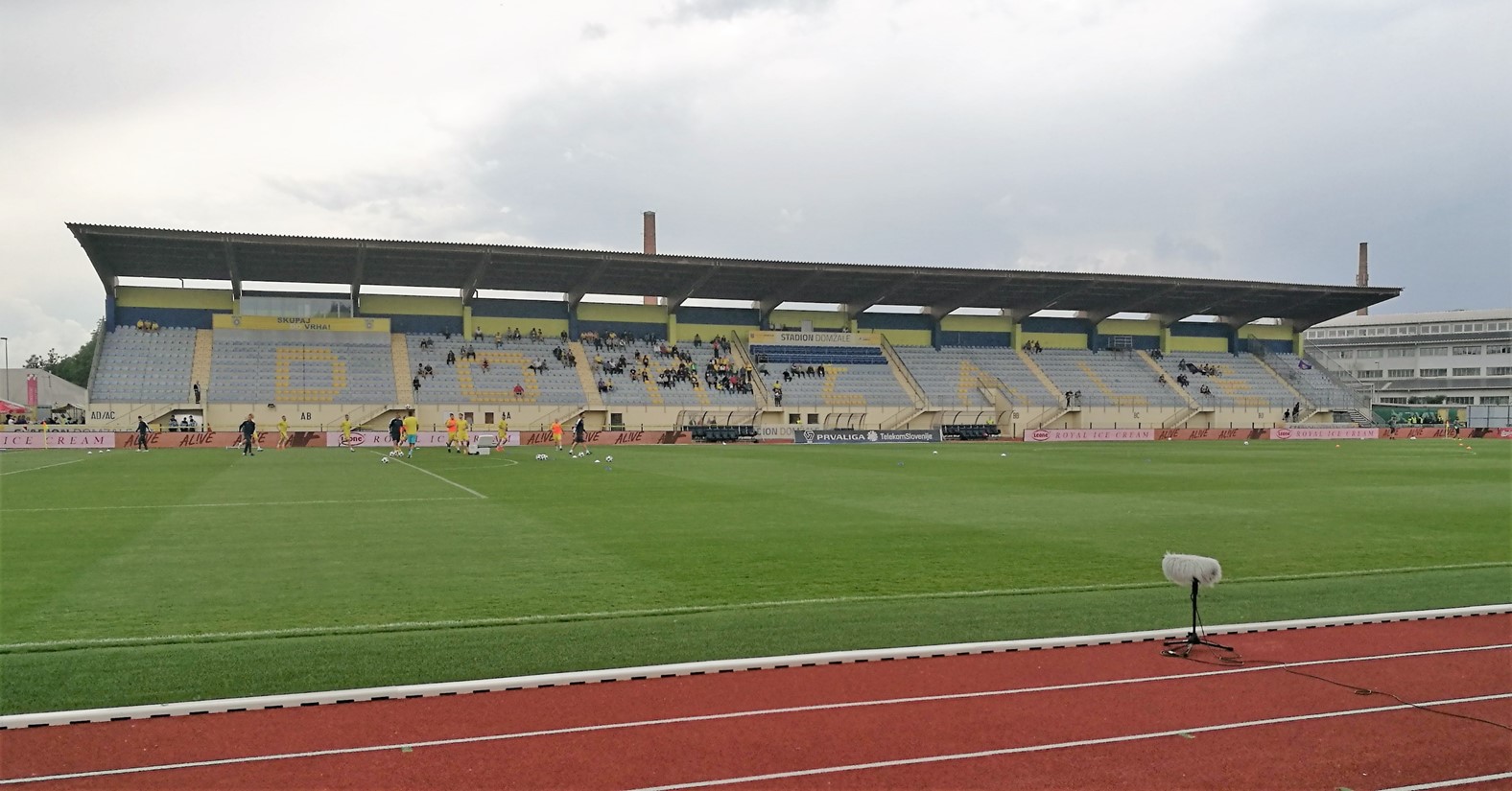
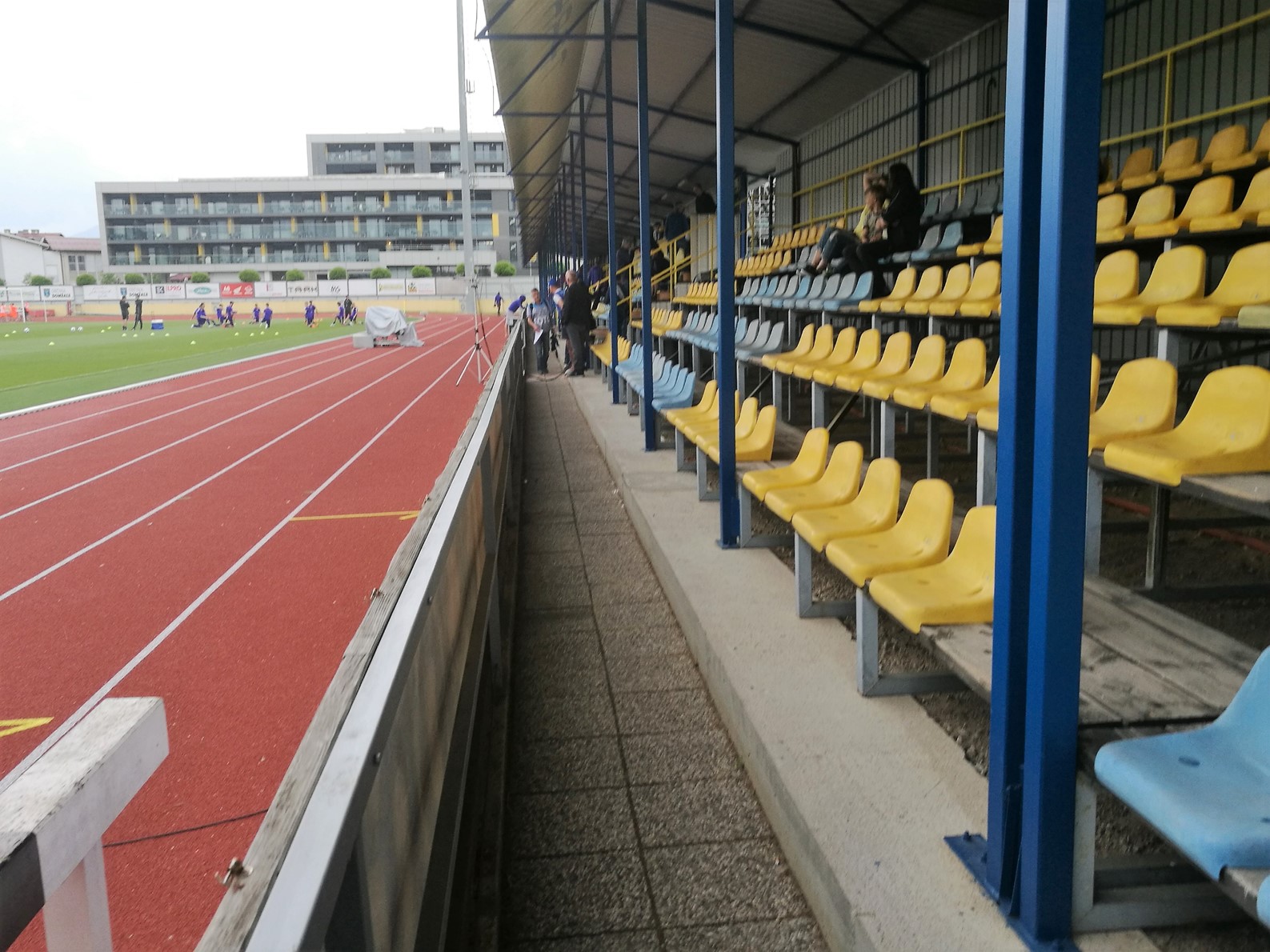
Domzale was the only one of the three grounds which had a covered area opposite the main stand, this was mainly given over to VIP and press seats. Thanks to Pizzaman having made an advance application, we were allowed into this area. The press appeared to have no access to the refreshment areas on the other side of the ground at all, while VIP’s had to walk around behind the goal, crossing the line of players entering and leaving the pitch to get their fill.
Over the two-day period, we were to see the top five teams in the ten-team division, and Triglav Kranj, placed bottom. Slovenia gets one place in Champions League qualifying, and three for the Europa League. With five games to go, the title was between Maribor and Olimpija, with the Ljubljana team leading by one point. Domzale were third, but with little hope of catching the leading two, and already mathematically certain of maintaining a minimum of third place, which means they get European football. Celje (fourth) and Rudar Velenje (fifth) were battling for the fourth place in the hope that Olimpija would win the cup and give them European competition. Aluminij are the other cup finalists and are placed 8th, just about secure from relegation. Triglav started the round two points behind Ankaran Hrvatini. Both of this pair were promoted last season. The one that finishes bottom goes straight down, while the ninth place gets a play-off against the second division runners-up.
The first game set the scene for the football we were to see in Slovenia. Both teams liked to attack but did not commit many players to forward positions and moves tend to break down with a weak pass or a quick shot into a blocking player. On many other occasions we saw players in good attacking positions losing the ball as they were trying to get into a position to shoot on their best foot. When they shoot with the other foot, the ball goes off into the middle of nowhere.
Not surprisingly, considering the poor football on fare with the best teams in this league, not one member of the Slovenian football team which gave England a close run last autumn plays in the Slovenian League.
For most of the games, we were also treated to a series of poorly taken corners that either flew directly into the keepers’ hands or were easily headed away – and yet somehow corners led to late equalisers in both of my first two games.
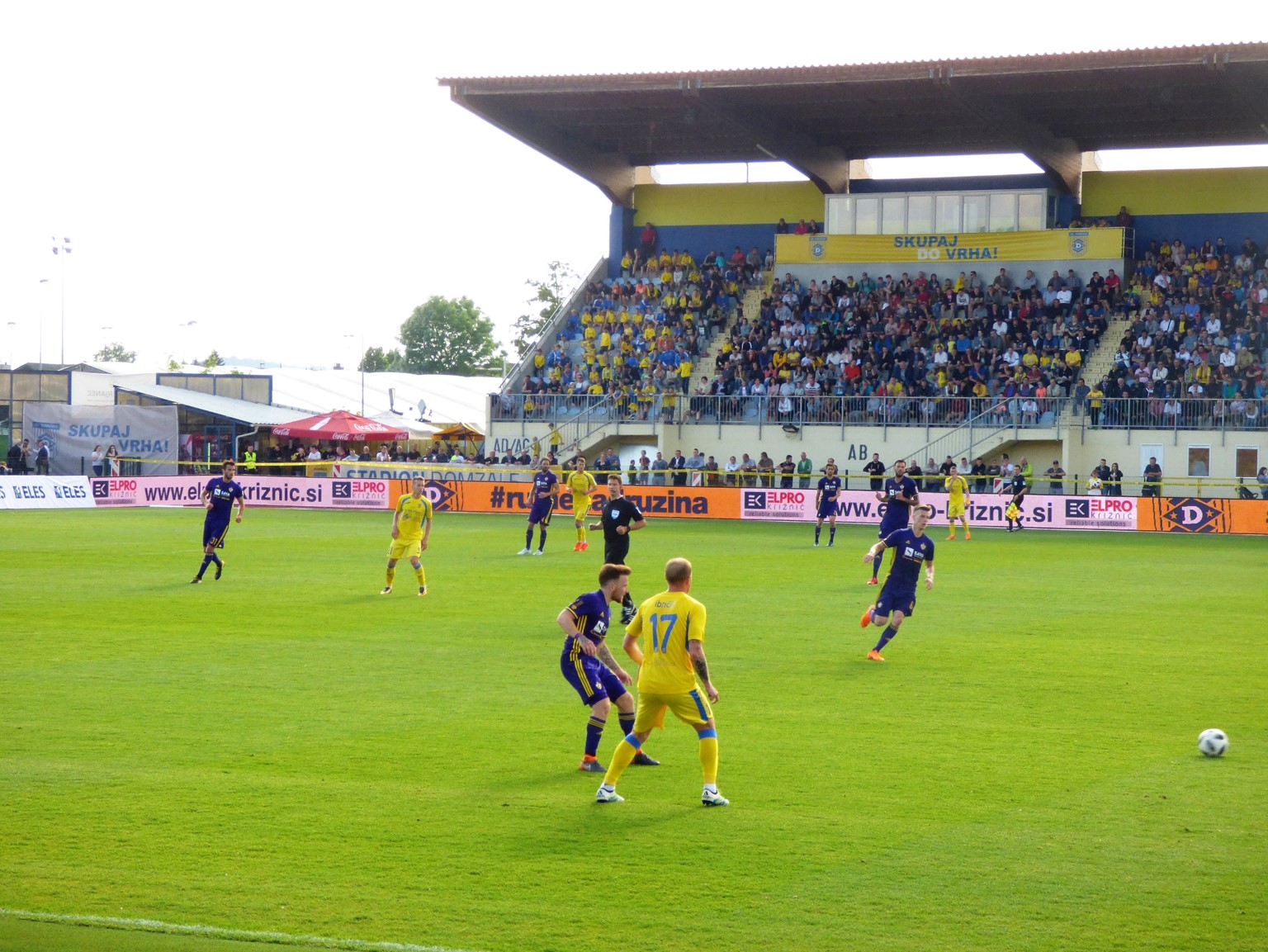
One felt from the way the games went, that both Maribor and Olimpija Ljubljana thought that they only had to run up in order to win their games, despite the relatively high positions of their opponents. Both got a shock to their systems. Maribor had been well on top of the game at Domzale, but then went behind early in the second half. The goal came from an error which allowed a free run on the target. Admittedly, based on what I had already seen, there was no certainty the ball would be hit at the goal until the shot was unleashed, but for close on to forty minutes, Maribor were behind.
The equaliser came in the “final minute”, although we still had several minutes for injury and time wasting to add. I see that different web sites give a different scorer. The Slovenian League site gives it to Dervisevic, who took the corner from the right. When this reached the near post, three players went up for it. Two defenders and Marcos Tavares. I thought it was Tavares who got the touch, but even watching the video several times, I cannot say that for certain. Whoever headed the ball, it then bounced down and went through the goalkeeper’s legs, with him getting the final touch. Domzale tried to claim the ball did not cross the line, but in these games, we had no less than six officials, and if assistants behind the goal lines have any purpose, then it is to confirm whether or not the goal went in. For this, the video does confirm that the officials were correct in awarding the goal. Soccerway gives the goalscorer as Tavares, a Brazilian born player who has been a regular with them for ten years. I am going along with that.
The crowd was given as 2500. In all three cases on this trip, I felt there was a discrepancy between the number given as crowd, and the numbers actually present.
By car, it was an easy run from Domzale to Velenje – with the most traffic we encountered being on exit of the car park, (and that added less than five minutes to the time). When we arrived at the stadium in Velenje, all was quiet – and the arrival a minute or two later of a coach carrying Olimpija Ljubljana fans, not a lot changed. A quick investigation revealed not only that the only refreshment stall at the ground was again limited to cold drinks, but also that it would not even be open until shortly before kick-off.
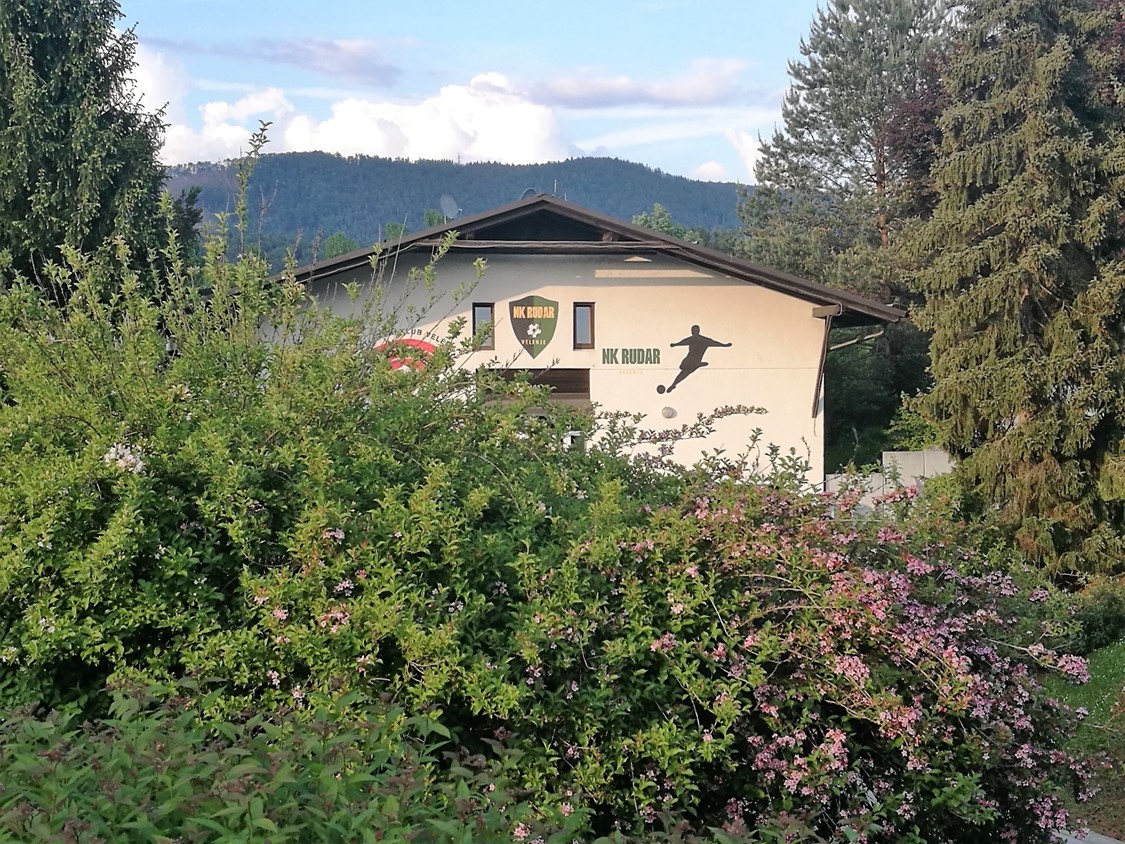
Pizzaman was complaining about the fact he had not eaten since breakfast, and I fancied I could do with a snack. I was missing the sausages that are DE rigour at German and Austrian grounds. Fortunately there was a bar just across the car park from the entrance. It appeared to be styled as a trendy spot, but all it could offer was beer and a toasted tuna sandwich. Naturally given this choice, we settled for a beer and a toasted tuna sandwich.
Pizzaman in search of the all elusive sandwich
The ground is basically one sided. The ascetically pleasing wrap round roof is surprisingly not cantilever and has uncovered seating extending out from its ends. At the far end, this was used as the enclosed section for the Olimpija ultras. For most of the rest of the ground, there is nowhere for spectators to go, and a small area of uncovered standing behind the near goal was not being used. This end was more notable for the impressive street are mural favouring the home club
The game followed a similar pattern to the one earlier in the day, with Olimpija clearly the better side, but not being able to change this into goals. Where it did differ was it was Olimpija who opened the scoring, and the home side which managed to level the scores late in the day.
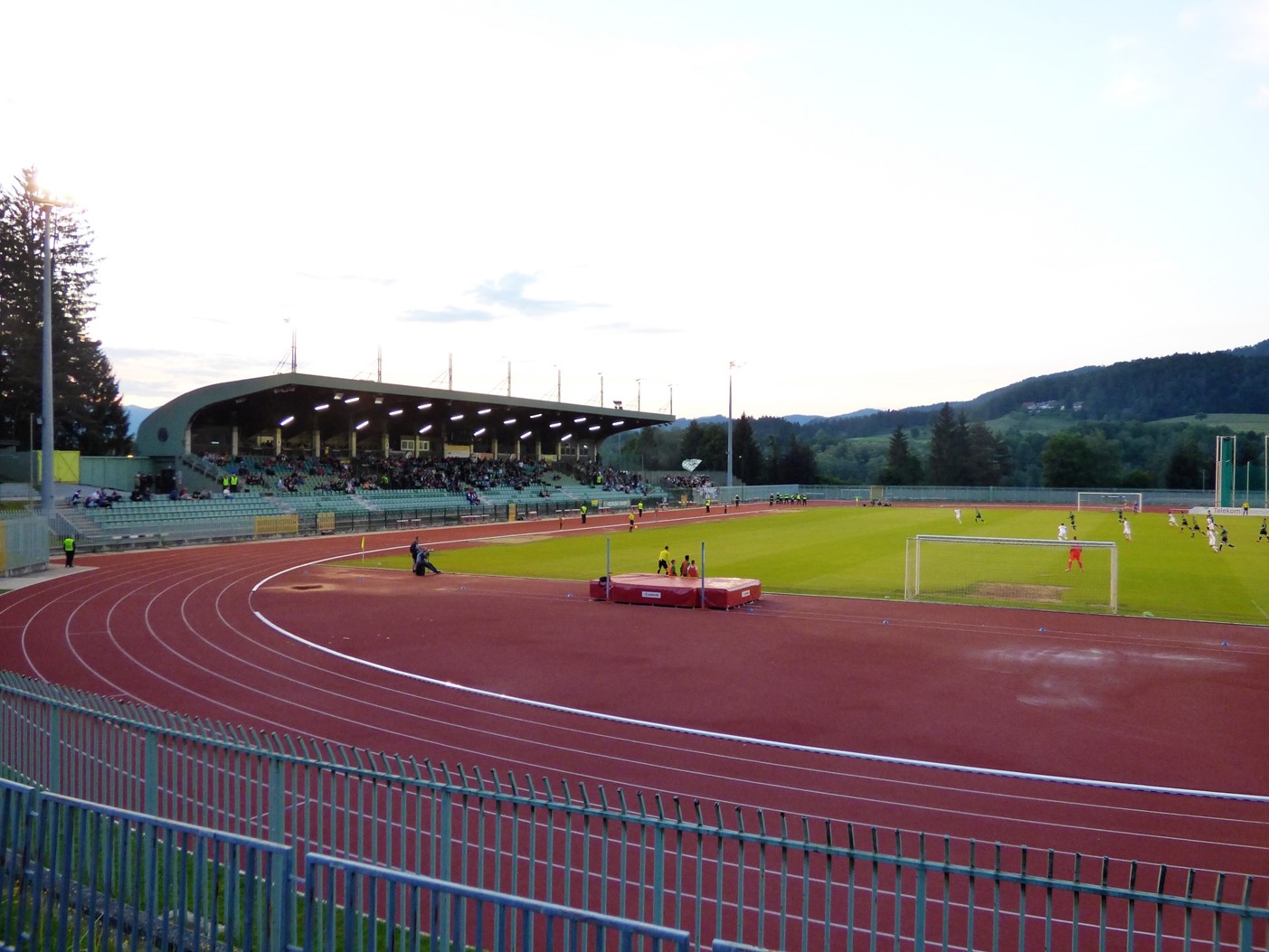
The following day, we had to return the car to Ljubljana, and we stopped briefly outside the old national stadium, not disused since the new stadium further out of town has been opened. Through gaps in the fencing, one can see what was once a large, if very open stadium, with no signs as yet of planning to redevelop the site.
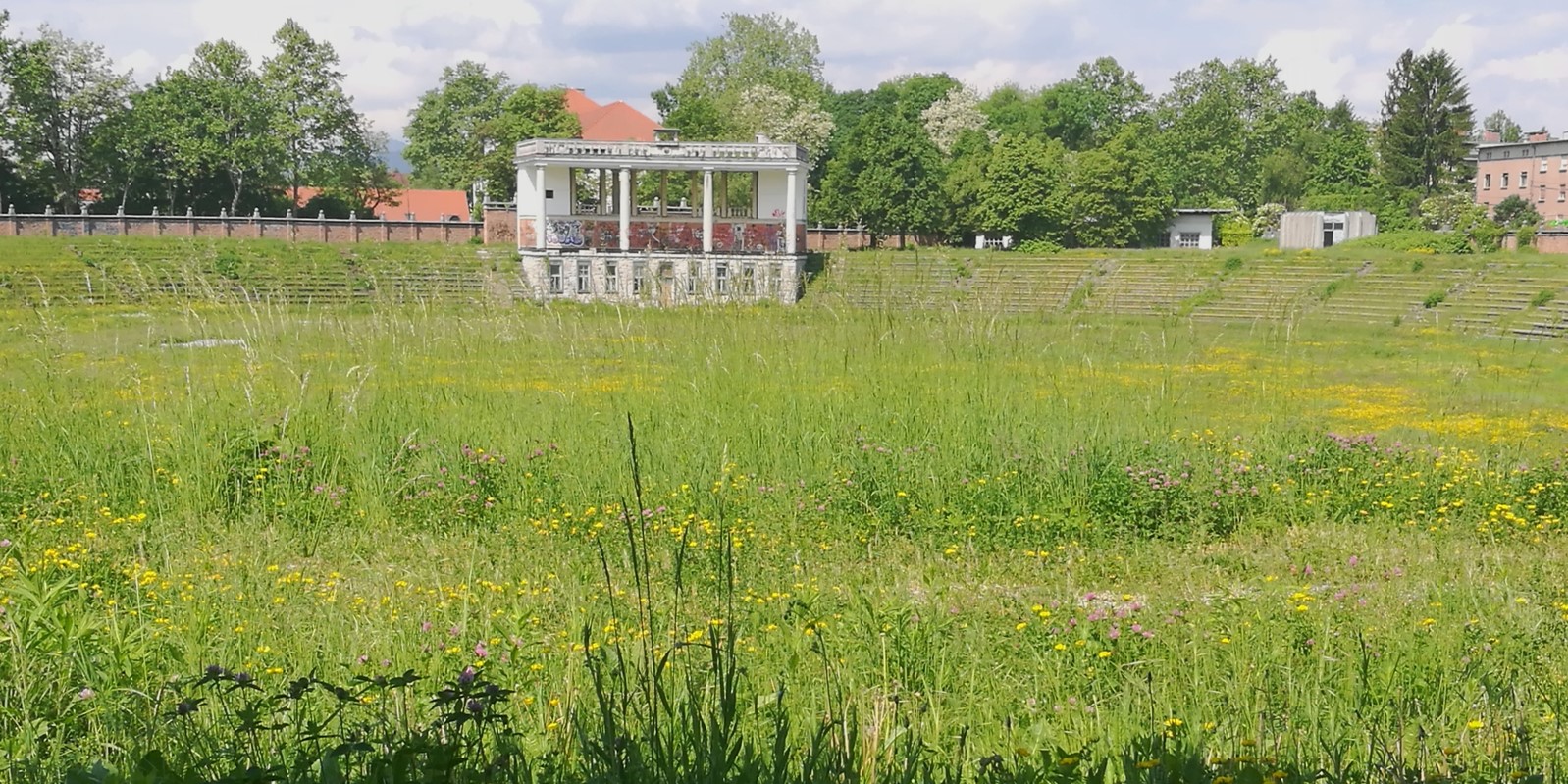
Having returned the car, it was back to the rails for the shortish trip to Kranj. This was probably the most interesting of the towns we were taking in, as well as the only one that we would actually take enough time to see. The old town is set on a rock that separates two rivers shortly before their confluence. From the station, we had to cross the larger river and then climb the hill into the town centre. Pulling my case, with one of the wheels having a tendency to seize up, this was a far bigger job than it might have been. Fortunately, once up the hill, we had just a couple of hundred yards to traverse on level ground, and then crossing a high-level bridge over the deep gorge of the tributary river. The hotel was next to the bridge. The ground was a short walk, crossing the bridge again.
The arrival at the sports complex which includes the ground is indicated by a statue of a naked man, hand raised presumedly in position to take a selfie of himself with the stadium and mountains in the background.
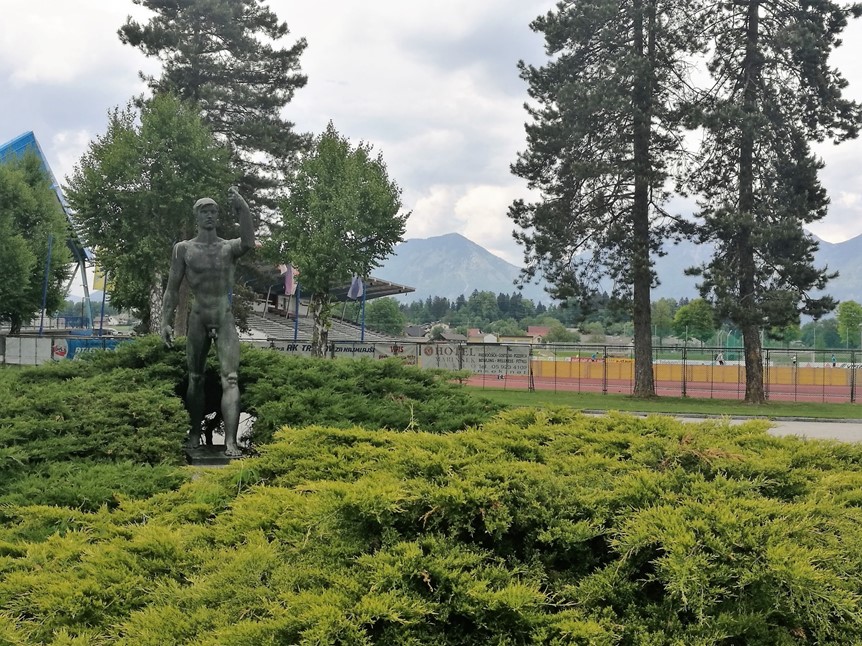
Again, we have a main stand on one side. In this case there are open seats on the other side, in a concrete block which has the dressing rooms underneath. The enclosed section for visiting ultras is within this section, but if there were any from Celje, they kept themselves anonymous and stayed on the other side of the ground. This block is two sided, with a couple of rows of seats on the opposite side looking over a second pitch. While the main pitch is glass and not floodlit, the second one is artificial and floodlit. There were children’s training sessions on this while the game was on the other side.
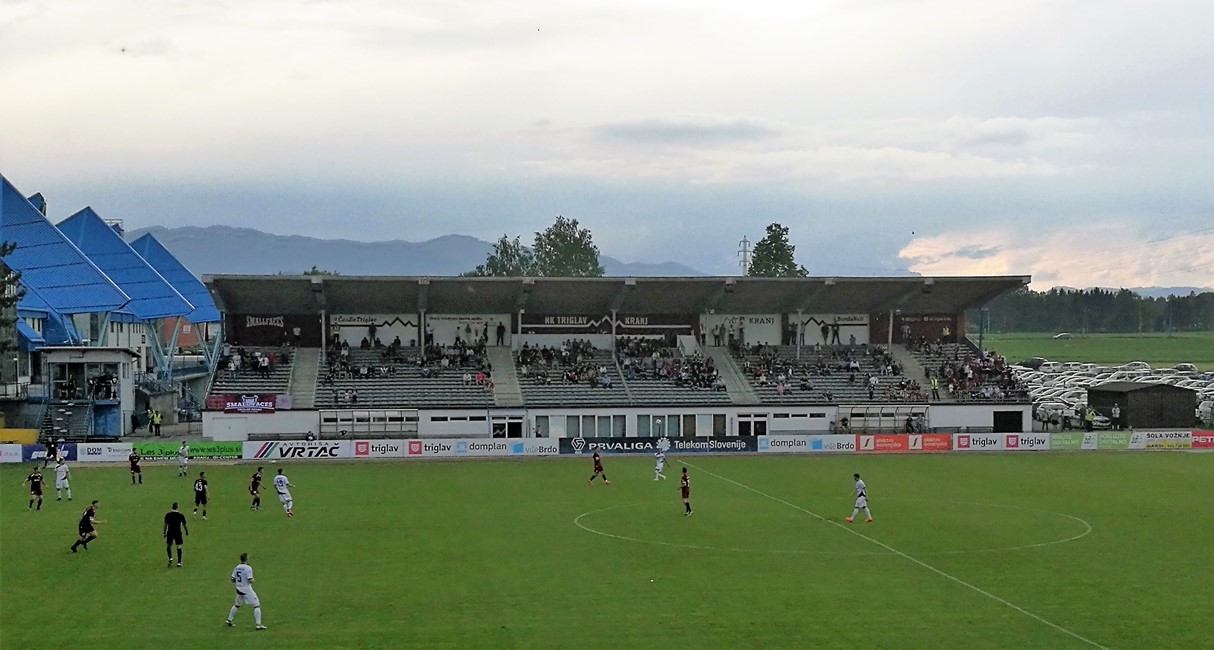
One has to go outside the ground to transfer from one side to another, but with just a wire fence, the views from here are better than inside some grounds, and a few had elected to watch all or part of the match from outside. The home teams is known as Triglav Kranj, and has apparently borne this name for over 60 years. We felt that the name was a reference to the highest mountain in Slovenia, and not a sponsor, although you may notice the name Triglav on advertising boards at most Slovenian league games.
Triglav have their own “singing section”, called the Small Faces, who have one end of the stand. For a 16.00 kick off on a working day, the numbers here were limited.

At the other end of the stand were a larger group of school children who also did their best to enliven proceedings with chants. Efforts that were appreciated by the crowd. The match, as with the others we had seen in Slovenia did not add up to a great deal. Triglav started the day bottom of the league, but a 1-0 win in this game allowed them to climb one place, which would give them the potential to avoid relegation via a play-off. Both of the bottom two had won promotion last season.
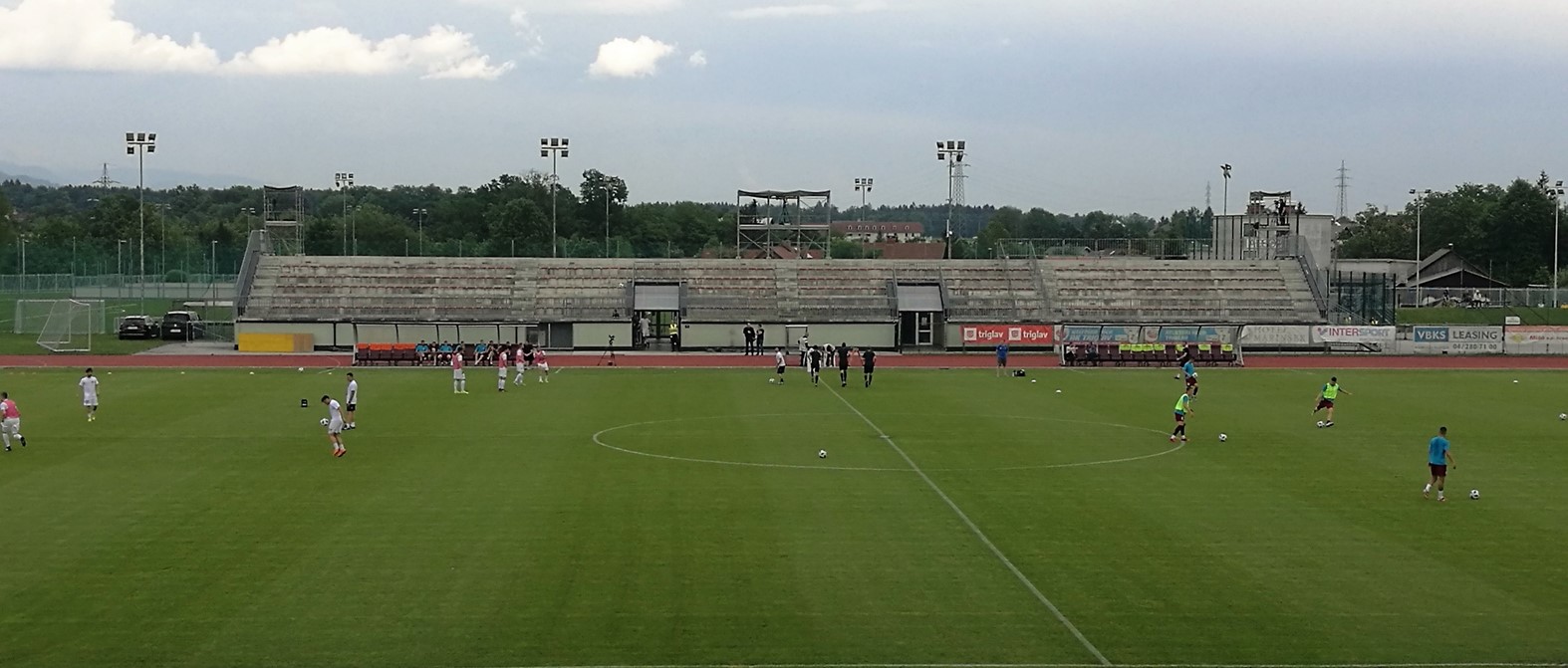

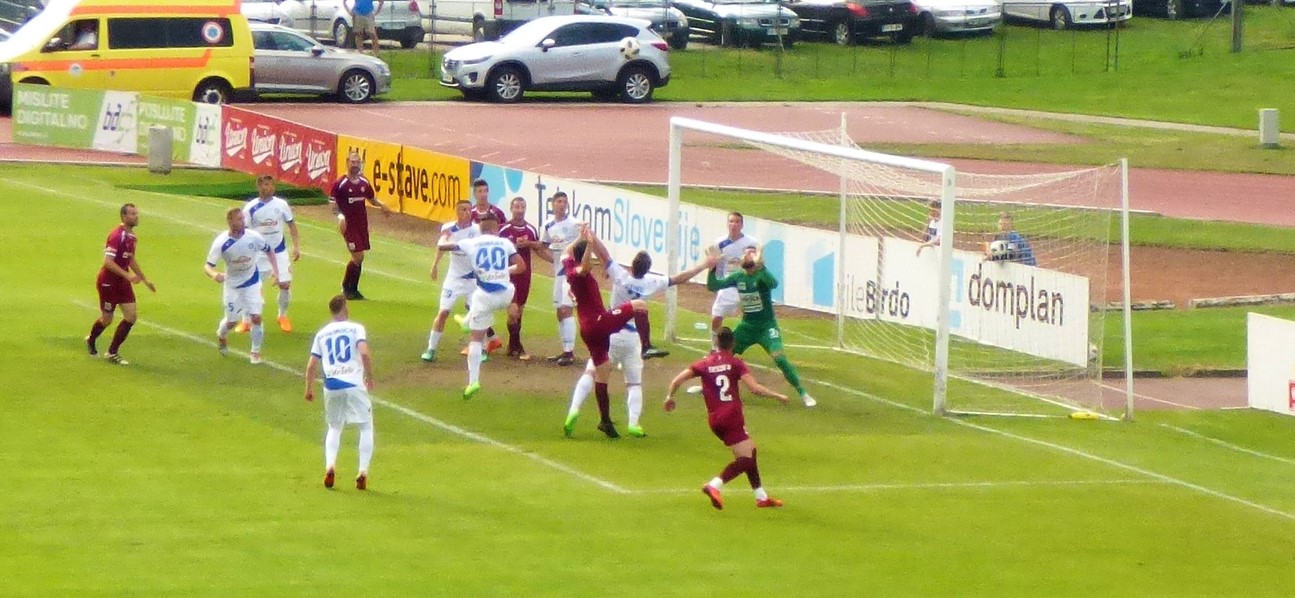
The result was a poor one from Celje, reducing their chances of finishing ahead of Rudar Velenje for what could be a place in the Europa League. Their chances were further diminished the following weekend, when they were beaten at home by Rudar (?)
After the match, Pizzaman and I headed into the town, and found the Teresa bar, which sold beers supplied by Kranj’s small brewery. A change from the mass-produced beers of the main Slovenian brewers. We settled on the Rye beer, and very nice it was. The locals here were in good form and quickly struck up conversation in English, which helped us to extend our stay in the bar. They even gave us a lift back to the hotel, where the local Kranjska Sausages were a speciality.
The next morning, there was a break in the smooth running of operations. We had our breakfast and made our way down the hill in time to have a coffee in the station café before the train was due. Then we waited, and waited. OK, in reality the train was only 30 minutes late, but it was running just to cross the border in Austria, and then we were both intending to board a connection to Vienna, dump our bags in a locker and go to different games before meeting up again in Vienna for the night train to Germany.
The consequence of the delay was the connection was missed, a two hour wait for the next one. Pizzaman wanted to go to Ebreichsdorf, while I preferred SKU Amstetten in the same division. The two carriages that came up through Kranj would have normally been attached to another train at Villach and taken to Frankfurt. Because of the delay, this was changed with our train terminating in Villach, but the Frankfurt train would at least wait, unlike the Vienna one. Judging by the effect of the train conductor’s comments when he walked through, around half the passengers were going each way – almost none were heading to Villach itself. So while Pizzaman waited for his train, and by slightly changing route, arrived at his destination by 18.00.
My journey was somewhat more straightforward. I took the Frankfurt connection as far as Salzburg, where there is a train every 30 minutes to Amstetten, arriving more than 3 hours before kick-off. On a sunny afternoon, Amstetten is a pleasant enough town, and I wandered around a little, stopping at an ice cream parlour before heading down to the ground. The stadium is about a ten minute walk from the station close to the river. The leisure area has a theatre, as well as many different sports facilities.

The venue is three sides, with one end giving way to nothing except a fence to the tennis courts. The other three sides have a modern appearance and have clearly been designed with the size of the club in mind.
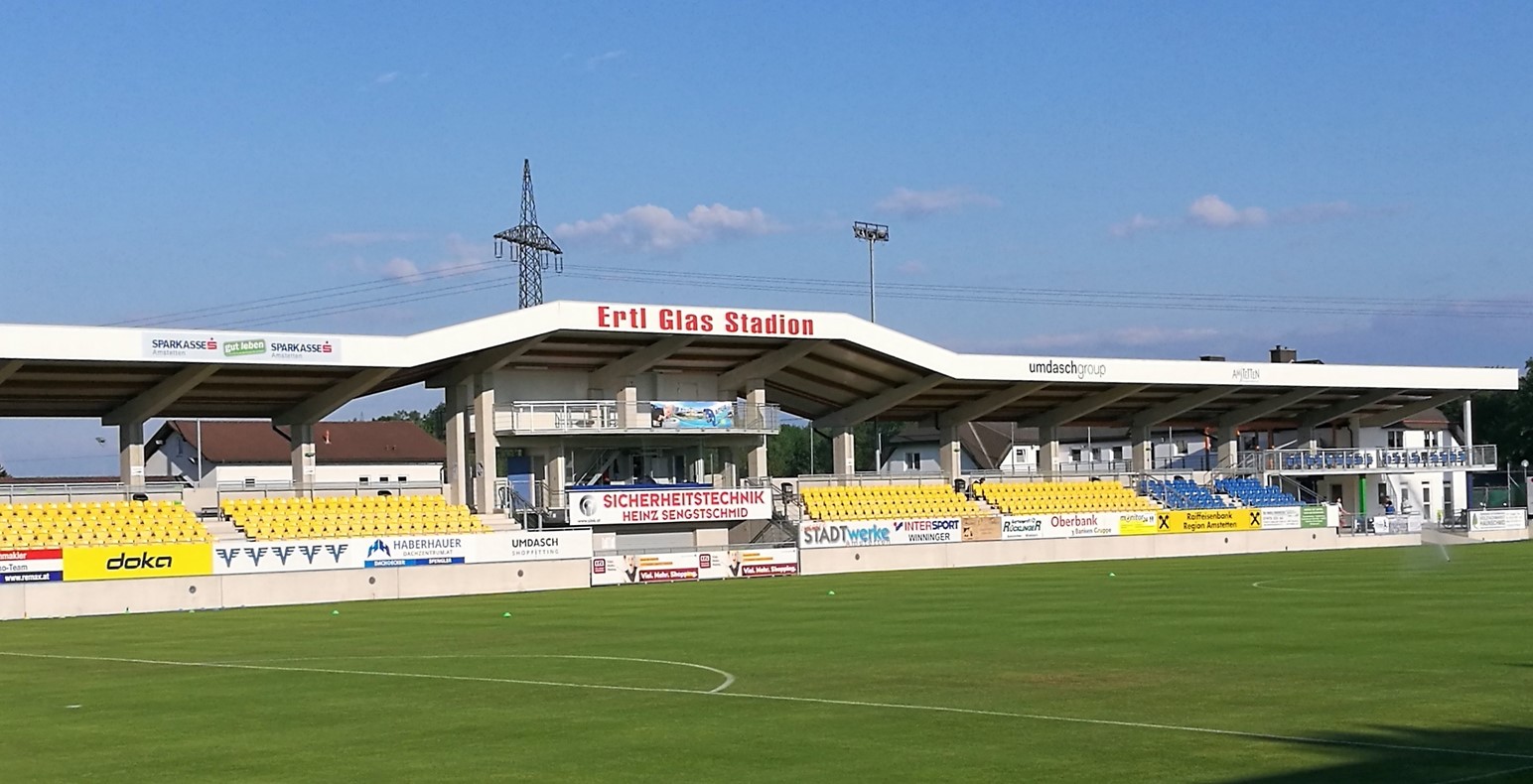
The ground looks close to full with 1450 in it for my game and would not look empty with only a third of the capacity. Naturally, it would struggle to hold 3000, but that type of point tends to be moot in Austria. The average crowd at Amstetten is a little short of 1,000 – still better than some in the division above.
Behind the goal, there is a fairly wide concourse, and close to food and drink outlets at both ends, there are bar tables, so as one can stand, with a beer and still watch the game. There are also ledges to place your beer glasses in the standing areas behind the seats.
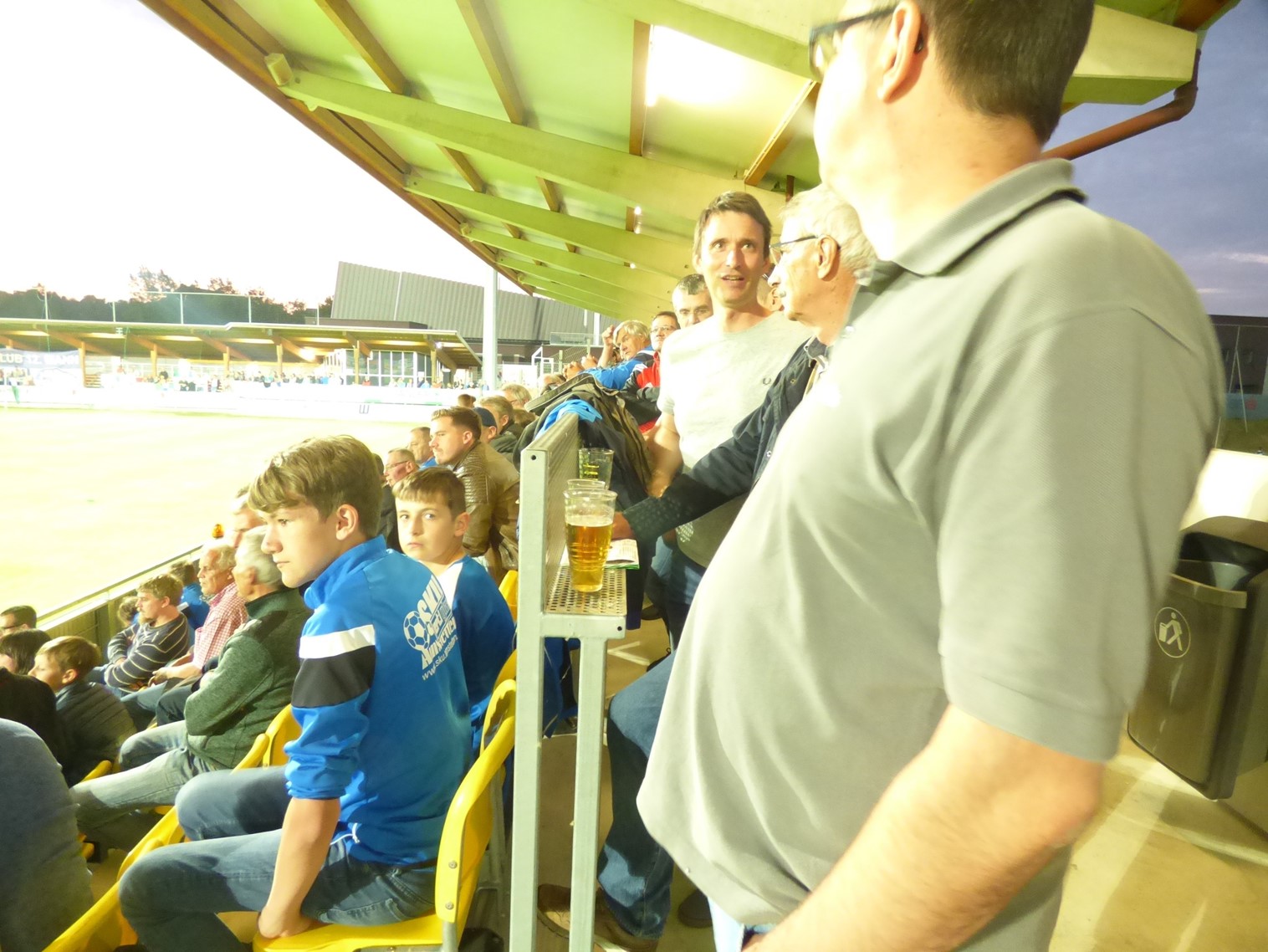
Austrian civilization – beer and football
Covered seats go around all three sides that are pen for spectators, but one section, behind the goal is reserved for their “12th Man” group – the singing fans who come equipped with drums, a strobe light and occasional apparently smoky wafts, not smoke bombs, but apparently dry ice. At times it looks more like a disco than a football ground
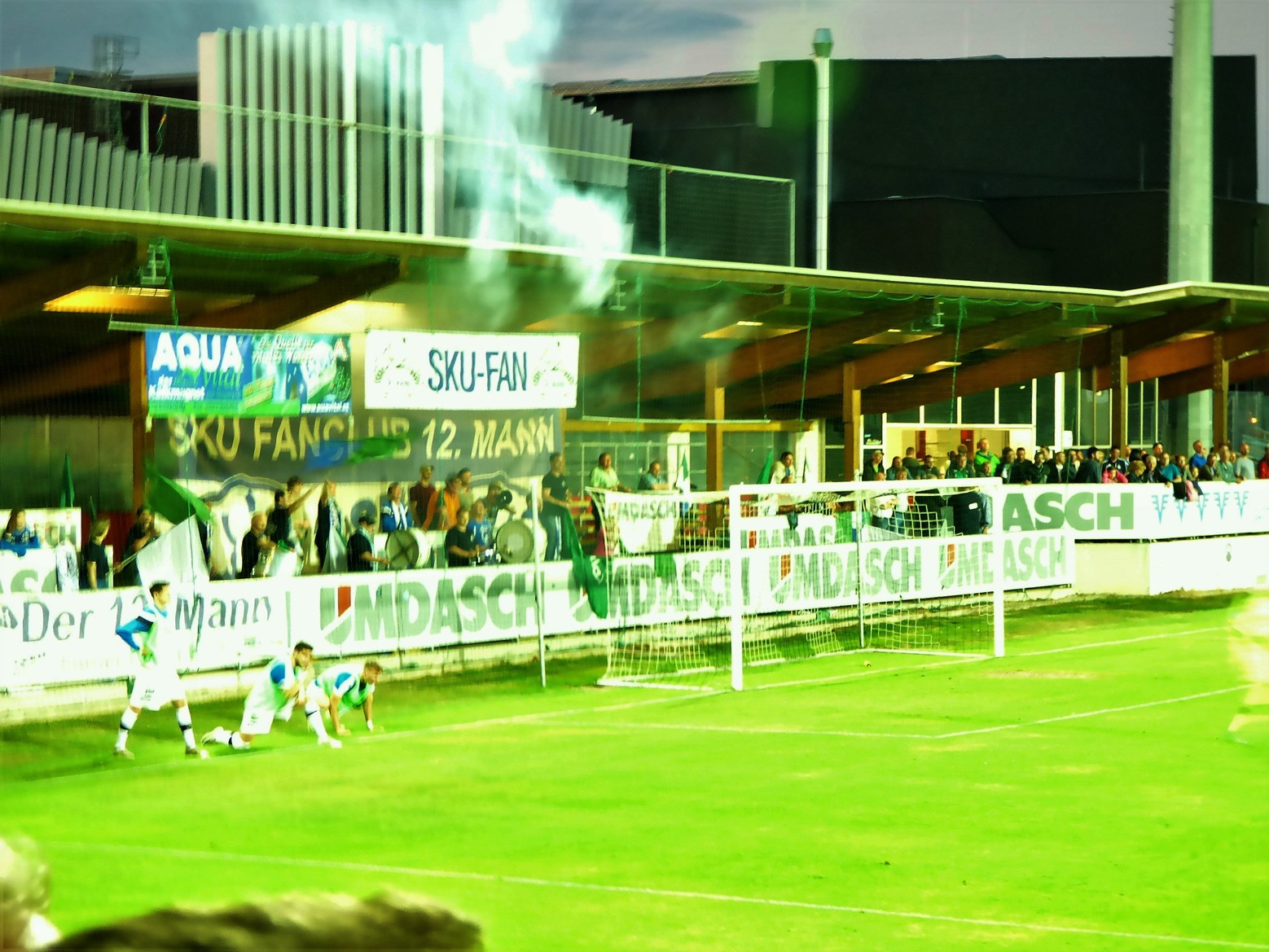
One of the first things I asked at the ground was the situation with regard to promotion. Having been given four names from the Mitte earlier in the week, I was pleased to fill in the one (Wacker Innsbruck reserves) from the West. As far as the Regionalliga Ost is concerned, my feeling the Ebreichsdorf would not be promoted was correct, this being one of the reasons I preferred the idea of going to Amstetten. League leaders (at arrival), SV Horn will go up, with two from Amstetten, Austria Wien reserves and Karabakh. With the latter two playing each other at the same time as my game knew that if they won this one, they were promoted.
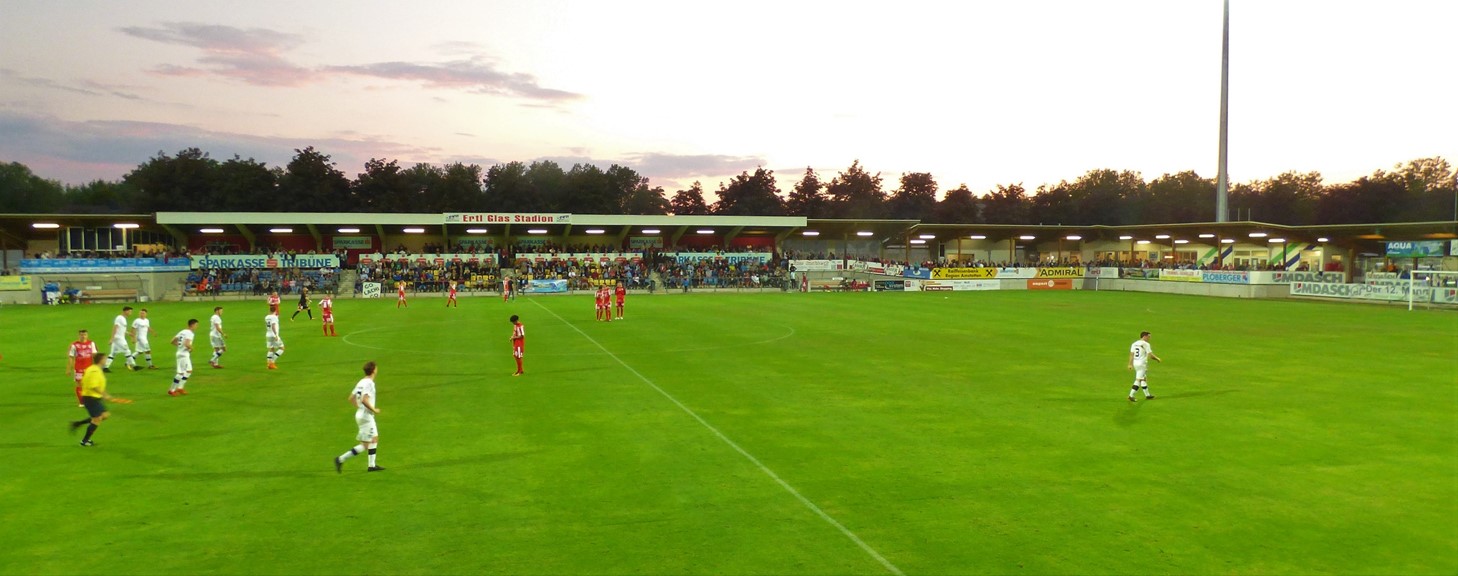
It took a while for the game to settle down, and while deserving it, Amstetten were fortunate with the incident that led to the first goal. The visiting keeper failed to hold the ball, and as Markus Keusch was trying to control it, he was fouled from behind. A completely unnecessary foul on a player facing away from goal. Milan Vukovic scored the penalty, the first of hat-trick (completed with a later penalty). Two goals in a minute early in the second half put Amstetten completely in control, and the score went up to 6-0 when Vukovic scored his second penalty. That incident left Bruck with ten men, but Amstetten did not score again until injury time. A final score of 7-0 left them in an emphatic conclusion to their promotion campaign
I stayed long enough to see the start of a celebration that I suspect was still going on after I had changed trains in Vienna, meeting Pizzaman again and heading to Germany
